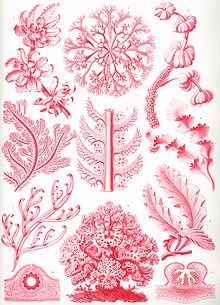
Brown algae, comprising the class Phaeophyceae, are a large group of multicellular algae, including many seaweeds located in colder waters within the Northern Hemisphere. Brown algae are the major seaweeds of the temperate and polar regions. They are dominant on rocky shores throughout cooler areas of the world. Most brown algae live in marine environments, where they play an important role both as food and as a potential habitat. For instance, Macrocystis, a kelp of the order Laminariales, may reach 60 m (200 ft) in length and forms prominent underwater kelp forests. Kelp forests like these contain a high level of biodiversity. Another example is Sargassum, which creates unique floating mats of seaweed in the tropical waters of the Sargasso Sea that serve as the habitats for many species. Many brown algae, such as members of the order Fucales, commonly grow along rocky seashores. Some members of the class, such as kelps, are used by humans as food.

Coralline algae are red algae in the order Corallinales. They are characterized by a thallus that is hard because of calcareous deposits contained within the cell walls. The colors of these algae are most typically pink, or some other shade of red, but some species can be purple, yellow, blue, white, or gray-green. Coralline algae play an important role in the ecology of coral reefs. Sea urchins, parrot fish, and limpets and chitons feed on coralline algae. In the temperate Mediterranean Sea, coralline algae are the main builders of a typical algal reef, the Coralligène ("coralligenous"). Many are typically encrusting and rock-like, found in marine waters all over the world. Only one species lives in freshwater. Unattached specimens may form relatively smooth compact balls to warty or fruticose thalli.

Gelidium is a genus of thalloid red algae comprising 134 species. Its members are known by a number of common names.

The ochrophytes is a group of mostly photosynthetic stramenopiles (heterokonts). Their plastid is of red algal origin.
In algal anatomy, a pit connection is a hole in the septum between two algal cells, and is found only in the red algae − specifically, all orders except the Porphyridiales and haploid Bangiales. They are often stoppered with proteinaceous "pit plugs". By contrast, many fungi contain septal pores − an unrelated phenomenon.

Red algae, or Rhodophyta, are one of the oldest groups of eukaryotic algae. The Rhodophyta comprises one of the largest phyla of algae, containing over 7,000 currently recognized species with taxonomic revisions ongoing. The majority of species (6,793) are found in the Florideophyceae (class), and mostly consist of multicellular, marine algae, including many notable seaweeds. Red algae are abundant in marine habitats but relatively rare in freshwaters. Approximately 5% of red algae species occur in freshwater environments, with greater concentrations found in warmer areas. Except for two coastal cave dwelling species in the asexual class Cyanidiophyceae, there are no terrestrial species, which may be due to an evolutionary bottleneck in which the last common ancestor lost about 25% of its core genes and much of its evolutionary plasticity.

The extinct Solenoporaceae have traditionally been interpreted as a group of red algae ancestral to the Corallinales.

Kappaphycus is a genus of red algae. Species are distributed in the waters of East Africa, Indonesia, Malaysia, Hainan Island, the Philippines, and Micronesia.

Cyanidiophyceae is a class of unicellular red algae within subdivision Cyanidiophytina, and contain a single plastid, one to three mitochondria, a nucleus, a vacuole and floridean starch. Most are extremophiles inhabiting acid hot springs. The main photosynthetic pigment is C-phycocyanin. Reproduction is asexual by binary fission or formation of endospores. After the first massive gene loss in the common ancestor of all red algae, a second gene loss occurred in the ancestor of Cyanidiophyceae. Since then, some gene gains and minor gene losses have taken place independently in the Cyanidiaceae and Galdieriaceae, leading to genetic diversification between the two groups, with Galdieriaceae occupying more diverse and varied niches in extreme environments than Cyanidiaceae.
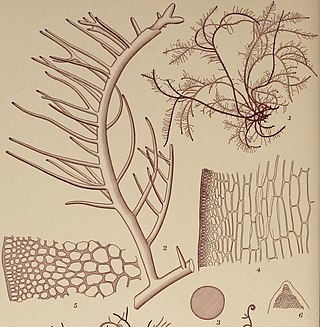
Hypnea is a genus of red algae, and a well known carrageenophyte.

Hapalidiaceae is a family of red alga belonging to the order Corallinales.
Galdieria sulphuraria is an extremophilic unicellular species of red algae. It is the type species of the genus Galdieria. It is known for its broad metabolic capacities, including photosynthesis and heterotrophic growth on over 50 different extracellular carbon sources. The members of the class Cyanidiophyceae are among the most acidophilic known photosynthetic organisms, and the growth conditions of G. sulphuraria – pH between 0 and 4, and temperatures up to 56 °C – are among the most extreme known for eukaryotes. Analysis of its genome suggests that its thermoacidophilic adaptations derive from horizontal gene transfer from archaea and bacteria, another rarity among eukaryotes.
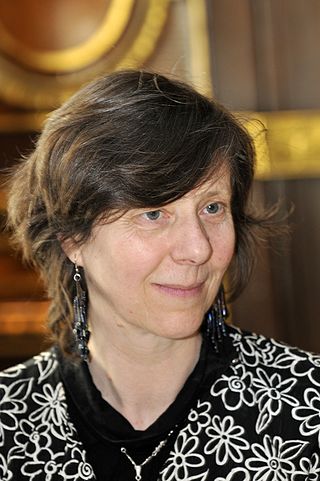
Christine Adair Maggs is a British phycologist. Formerly Executive Dean of the Faculty of Science & Technology at Bournemouth University, she is now the Chief Scientist of the Joint Nature Conservation Committee.

Batrachospermaceae is a family of fresh water red algae (Rhodophyta). Genera within the Batrachospermaceae generally have a "Lemanea-type" life history with carpospores germinating to produce chantransia. Sporophyte phase with meiosis occurs in an apical cell to produce the gametophyte stage. Pit connections have two pit plug cap layers with the other layer enlarged. This family of freshwater red algae is uniaxial, meaning each filament with a single apical cell. The genera included within Batrachospermaceae are listed in the table below.

Cyanidiophytina is a subdivision of red algae.

Timothy John Entwisle, is an Australian botanist, much of whose research work is in phycology (algae). See for example the articles. He was awarded a Ph.D. from La Trobe University in 1986 for work on the taxonomy of Vaucheria.

Naccariaceae is a family of red algae in the order Bonnemaisoniales, with 3 monotypic genera that are found in both the Pacific and Atlantic Oceans.
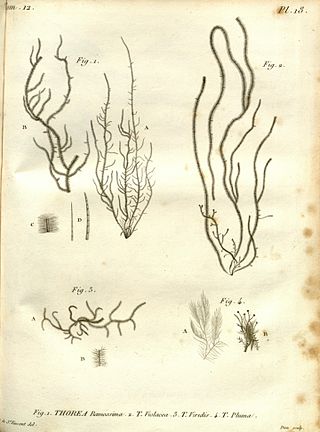
Thoreales is an order of red algae belonging to the class Florideophyceae. The order consists only one family, ThoreaceaeHassall, 1845. The family of Thoreaceae was circumscribed by Arthur Hill Hassall in A history of the British freshwater algae, including descriptions of the Desmideae and Diatomaceae in 1845.
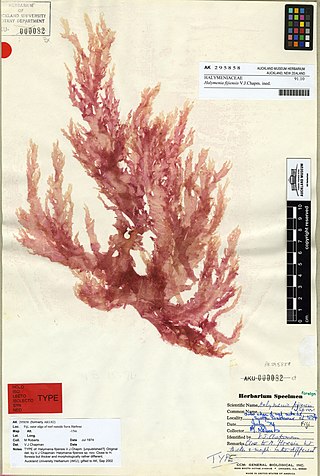
Halymeniales is an order of red algae belonging to the class Florideophyceae and the subclass Rhodymeniophycidae.

Peyssonneliales is a monotypic order of red algae belonging to the class Florideophyceae and the subclass Rhodymeniophycidae. It contains only 1 known family, PeyssonneliaceaeDenizot, M., 1968.
